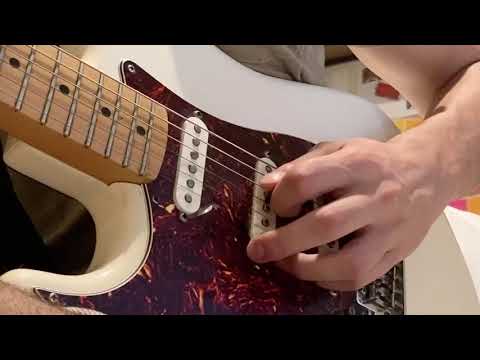Inspired by a recent video by Jason Richardson posted here, I made this tricky little neoclassical etude.
I think it’s good practice for both hands - fretting hand on learning conventionally barred arpeggios without barring, and picking hand on DBX.
Here is the guitar pro / tux guitar file. arpeggioetude.gp3 (1.9 KB)
It’s basically Am down, F up, G down, Em up, F down, Dm up, E down and a harmonic minor run.
E|-12-8-----8-----------------------------------------------------8-----12-|-10-7-----7-----------------------------------------------------7-----10-|
B|-------10----10----10----------------------------------10----10----10----|-------8-----8-----8-----------------------------------8-----8-----8-----|
G|----------------9-----9-----9-----------------10----10----10-------------|----------------7-----7-----7-----------------9-----9-----9--------------|
D|-------------------------10----10----------10----10----------------------|-------------------------9-----9-----------9-----9-----------------------|
A|----------------------------------12-8--12-------------------------------|----------------------------------10-7--10-------------------------------|
E|-------------------------------------------------------------------------|-------------------------------------------------------------------------|
E|-8--5-----5-----------------------------------------------------5-----5--|-4----------------------------------------------------------|
B|-------6-----6-----6-----------------------------------6-----6-----6-----|----5-----5-------------------------------------------------|
G|----------------5-----5-----5-----------------7-----7-----7--------------|-------4-----4-----7--5--4----------------------------------|
D|-------------------------7-----7-----------7-----7-----------------------|----------------6-----------7--6--3-------------------------|
A|----------------------------------8--5--8--------------------------------|-------------------------------------7--5--3----------------|
E|-------------------------------------------------------------------------|----------------------------------------------7--5--4--5----|
For the F barre arpeggio I use the same fingering as for the Am (middle, index, middle for D,G,B strings respectively). For the Em and Dm barre I use middle, ring, middle for D,G,B. It takes a bit of getting used to if you’ve been rolling your finger but I think it pays off.
As for picking, I practice two ways.
1- Economy/directional picking where I do a downstroke when switching to a higher string and upstroke when switching to a lower string. I.e.
D U U D U U D U U D U U D U D D U D D U D D U D U D U D U U D U U D U U D U D D U D D U D D U D
E|-12-8-----8-----------------------------------------------------8-----12-|-10-7-----7-----------------------------------------------------7-----10-|
B|-------10----10----10----------------------------------10----10----10----|-------8-----8-----8-----------------------------------8-----8-----8-----|
G|----------------9-----9-----9-----------------10----10----10-------------|----------------7-----7-----7-----------------9-----9-----9--------------|
D|-------------------------10----10----------10----10----------------------|-------------------------9-----9-----------9-----9-----------------------|
A|----------------------------------12-8--12-------------------------------|----------------------------------10-7--10-------------------------------|
E|-------------------------------------------------------------------------|-------------------------------------------------------------------------|
It still needs DBX but it’s inside picking. I think I tend to use a forearm helper motion to do these. Here is my attempt at slow, medium, fast tempo. Timing is tough, and I have more trouble with ascending than descending.
2 - Alternate picked. I’m not sure what motion I use here but I think it’s a supinated wrist + forearm blend, at least at high speed (I might be hopping at slow speed). Also I’m definitely swiping and misplacing notes, it’s a work in progress!











